Reframing transforms conflicts by shifting perspectives to find shared meaning, while compromise often requires sacrificing individual needs to reach an agreement. Explore how mastering reframing can enhance your relationship dynamics in this article.
Table of Comparison
| Aspect | Reframing | Compromise |
|---|---|---|
| Definition | Changing the perspective of a conflict to find new meaning. | Both parties make concessions to reach a mutually acceptable solution. |
| Goal | Transform negative views into positive or neutral ones. | Balance differing interests by meeting halfway. |
| Approach | Cognitive and communication-based. | Negotiation and adjustment of demands. |
| Outcome | Improved understanding and perspective shift. | Partial satisfaction for both parties. |
| Best Use Case | When mindset and perceptions block resolution. | When timely agreement is needed, and flexibility exists. |
| Advantages | Encourages creativity and lasting mindset change. | Quick resolution and practical agreements. |
| Limitations | Requires open-mindedness and skillful communication. | May lead to unsatisfactory compromises or imbalance. |
Understanding Reframing and Compromise
Understanding reframing involves changing the way you perceive a situation to uncover new solutions or positive aspects, which enhances problem-solving and emotional resilience. Compromise requires both parties to make concessions, balancing differing needs to reach a mutually acceptable agreement while maintaining relationships. Your ability to distinguish between reframing and compromise can lead to more effective conflict resolution and personal growth.
Key Differences Between Reframing and Compromise
Reframing involves changing the perspective or context of a situation to find new solutions, whereas compromise requires both parties to make concessions to reach a middle ground. Reframing emphasizes creativity and problem-solving by altering the meaning or approach, while compromise typically involves negotiation and trade-offs that may leave both parties partially satisfied. Understanding these differences enables more effective conflict resolution by choosing strategies that either transform the issue or balance interests.
The Psychology Behind Reframing
The psychology behind reframing involves altering one's perception of a situation to change its emotional impact without modifying the facts, which enhances cognitive flexibility and emotional resilience. Unlike compromise, which requires negotiation and mutual concession, reframing shifts internal interpretation to reduce stress and foster problem-solving. This mental strategy activates neural pathways associated with positive thinking and adaptive behavior, promoting healthier responses to challenges.
Compromise: Benefits and Drawbacks
Compromise fosters collaboration by encouraging parties to find a middle ground, often leading to faster conflict resolution and sustaining relationships through mutual concession. However, compromise may result in suboptimal solutions where neither party fully achieves their goals, potentially causing dissatisfaction or resentment. Balancing benefits and drawbacks, compromise is most effective when both sides value maintaining harmony over maximizing individual gains.
When to Use Reframing in Conflict Resolution
Reframing in conflict resolution is most effective when you need to shift perspectives to break negative thought patterns and open pathways for understanding. Unlike compromise, which requires mutual concessions, reframing helps identify underlying interests and reframes disputes into collaborative solutions without sacrificing core values. Your ability to reframe can transform conflicts into opportunities for creative problem-solving and lasting agreement.
The Role of Compromise in Negotiation
Compromise plays a crucial role in negotiation by enabling parties to find a middle ground where each side concedes certain demands to reach a mutually acceptable agreement. Unlike reframing, which adjusts the context or perspective of the issues to create new solutions, compromise focuses on balancing interests through give-and-take. Effective compromise fosters collaboration and maintains relationships by preventing deadlock and promoting fair outcomes.
Strategies for Effective Reframing
Effective reframing strategies involve shifting your perspective to reinterpret a situation positively, empowering you to overcome challenges and reduce stress. Unlike compromise, which seeks a middle ground between conflicting interests, reframing transforms your internal narrative without sacrificing core values. Employ cognitive techniques such as identifying negative thought patterns and consciously replacing them with constructive alternatives to enhance emotional resilience and problem-solving skills.
Avoiding the Pitfalls of Compromise
Avoiding the pitfalls of compromise involves recognizing when concessions dilute core values or long-term goals, leading to suboptimal outcomes. Reframing challenges by altering perspectives fosters creative solutions that preserve interests without sacrificing key principles. Emphasizing reframing over compromise enhances problem-solving effectiveness while minimizing regret and dissatisfaction in negotiation processes.
Real-World Examples: Reframing vs Compromise
Reframing involves changing the perspective on a problem to find creative solutions, as seen in Steve Jobs' approach to transforming tech design challenges into innovation opportunities at Apple. Compromise requires both parties to make concessions, exemplified by political negotiations where conflicting interests settle on middle-ground policies. Real-world success often hinges on knowing when to reframe a challenge for breakthrough innovation or when to compromise to maintain collaboration and progress.
Choosing the Right Approach: Reframing or Compromise?
Choosing the right approach between reframing and compromise depends on the context and desired outcomes of a conflict resolution. Reframing shifts your perspective to transform problems into opportunities, fostering innovative solutions and deeper understanding, while compromise seeks a middle ground, balancing differing interests by making concessions from all parties involved. Your decision should align with whether the goal is to expand possibilities through mindset change or to find an equitable solution by mutual adjustment.

Infographic: Reframing vs Compromise
 relatioo.com
relatioo.com